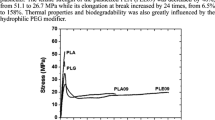Abstract
Three high molecular weight (120,000 to 200,000 g mol−1) polylactic acid (PLA) plastic films from Chronopol (Ch-I) and Cargill Dow Polymers (GII and Ca-I) were analyzed for their degradation under various temperature and relative humidity (RH) conditions. Two sets of plastic films, each containing 11 samples, were randomly hung in a temperature/humidity-controlled chamber by means of plastic-coated paper clips. The tested conditions were 28, 40, and 55°C at 50 and 100% RH, respectively, and 55°C at 10% RH. The three tested PLA films started to lose their tensile properties when their weight-average molecular weight (M w) was in the range of 50,000 to 75,000 g mol−1. The average degradation rate of Ch-I, GII, and Ca-I was 28,931, 27,361, and 63,025 M w/week, respectively. Hence, GII had a faster degradation rate than Ch-I and Ca-I under all tested conditions. The degradation rate of PLA plastics was enhanced by the increase in temperature and relative humidity. This trend was observed in all three PLA plastics (Ca-I, GII, and Ch-I). Of the three tested films, Ch-I was the first to lose its mechanical properties, whereas Ca-I demonstrated the slowest loss, with mechanical properties under all tested conditions.
Similar content being viewed by others

REFERENCES
R. Datta and S. P. Tsai (1997) in Fuels and Chemicals from Biomass, Am. Chem. Soc., Washington, DC, pp. 224–236.
Anonymous (1997) News from Cargill. Cargill Inc., MN, pp. 1–3.
G. B. Kharas, F. Sanchez-Riera, and D. K. Severson (1994) in D. P. Mobley (Ed.), Plastics from Microbes: Microbial Synthesis of Polymers and Polymer Precursors, Hanser Gardner, OH, pp. 93–137.
S. Schmidt and N. Padukone (1997) J. Ind. Microbiol. Biotechnol. 18, 10–14.
Y. N. Chang, R. E. Mueller, and E. L. Iannotti (1996) Plant Growth Regul. 19, 223–232.
R. Datta, S. P. Tsai, P. Bonsignore, S. H. Moon, and J. R. Frank (1995) FEMS Microbiol. Rev. 16, 221–231.
G. L. Siparsky, K. L. Voorhees, and F. Miao (1998) J. Environ. Polym. Degrad. 6, 31–41.
ASTM D638–95 (1996) in 1996 Annual Book of ASTM Standards, American Society for Testing and Materials, Villanova, PA, pp. 45–56.
ASTM D5296–92 (1996) in 1996 Annual Book of ASTM Standards, American Society for Testing and Materials, Villanova, PA, pp. 425–437.
SAS Institute Inc. (1997) SAS Computer Program, Version 6.03, SAS Institute Inc., Cary, NC.
G. L. Robertson (1993) in H. A. Hughes (Ed.), Food Packaging: Principles and Practice, Marcel Dekker, New York, pp. 9–62.
J. M. Mayer and D. L. Kaplan (1994) Trends Polym. Sci. 2, 227–235.
K. Jamshidi, S. H. Hyon, and Y. Ikada (1988) Polymer, 29, 2229.
E. S. Lipinsky and R. G. Sinclair (1986) Chem. Eng. Prog. 8, 26.
Author information
Authors and Affiliations
Rights and permissions
About this article
Cite this article
Ho, KL.G., Pometto, A.L. & Hinz, P.N. Effects of Temperature and Relative Humidity on Polylactic Acid Plastic Degradation. Journal of Polymers and the Environment 7, 83–92 (1999). https://doi.org/10.1023/A:1021808317416
Issue Date:
DOI: https://doi.org/10.1023/A:1021808317416



